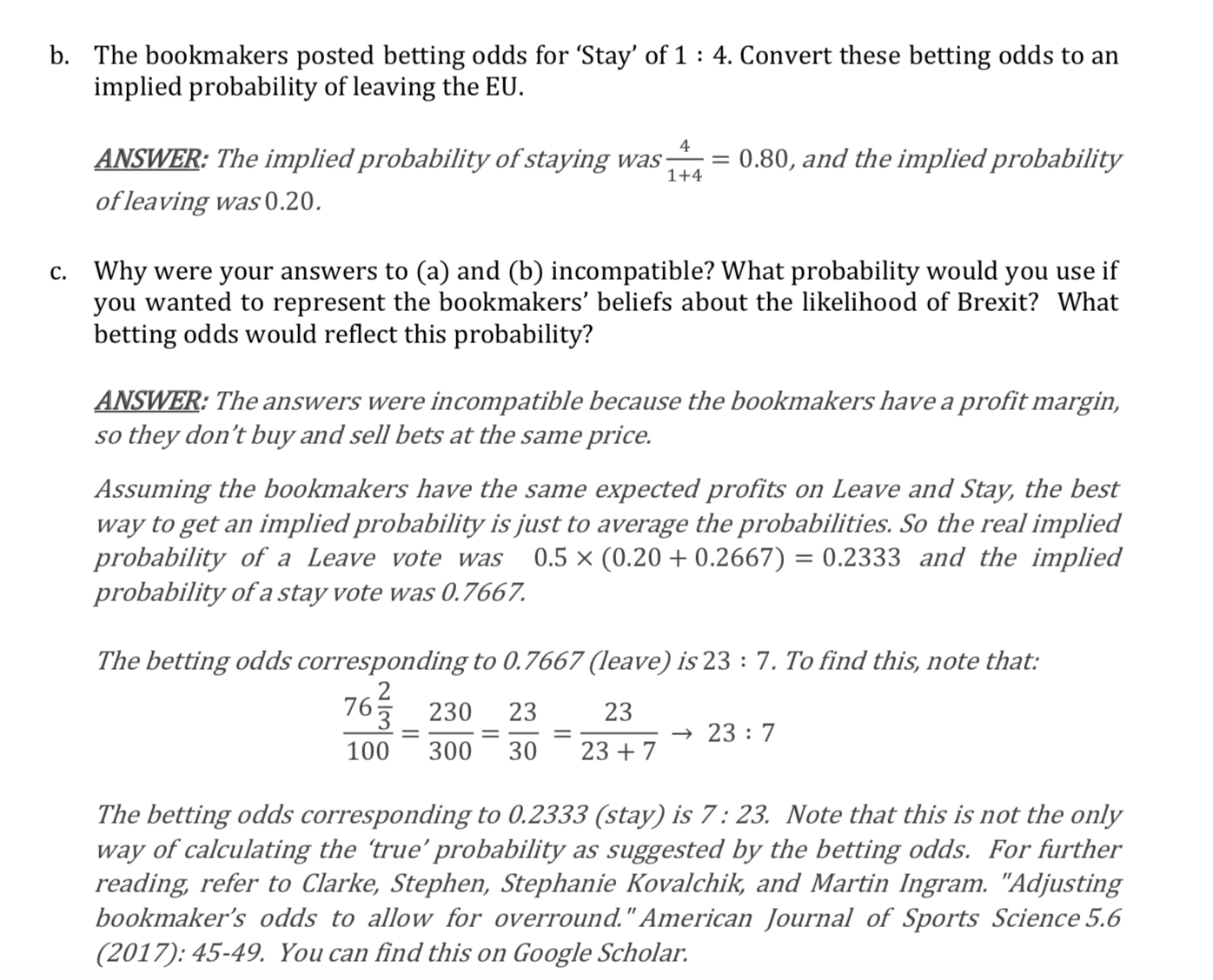

I have failed to understand the betting for odds, I am not sure how the formula comes from and how the probability was done, please explain step by step each each subparts, feel free to reference anything , please leave it if you are not confident, clear presentation prefer typing, thank you.
[n economics, we normally talk about probabilities, but betting markets normally work in terms of odds. It is straightforward to convert between odds and probabilities. In betting markets, \"betting odds" indicate the payment that will be awarded in the event of a successful bet. Take the example of betting on Brexit: in mid-May 2016, the bookmakers Ladbrokes, Coral, and William Hill all had the same published betting odds for the UK's referendum on whether or not to withdraw from the EU which was due to be held the following month. a. The betting odds for 'Leave' was posted as 11 : 4 (published as 11/4), meaning that a 4 bet on Leave would yield 11 in winnings (and the original 4 would be returned) in the event that the UK votes to leave. If the UK votes to stay, the 4 is lost and there are no winnings. What was the implied probability of leaving the EU from these betting odds? ANSPVER: The implied probability of staying can be found by solving the following the following odds ratio forp: = 0.7333, and the implied probabilityofleavingl 0.733 = 0.2667. b. The bookmakers posted betting odds for 'Stay' of 1 : 4. Convert these betting odds to an implied probability of leaving the EU. M: The implied probability of staying was i = 0.80, and the implied probability of lea ving was 0.20 . c. Why were your answers to (a) and (b) incompatible? What probability would you use if you wanted to represent the bookmakers' beliefs about the likelihood of Brexit? What betting odds would reect this probability? MEIER: The answers were in compatible because the bookmakers have a prot margin, so they don 't buy and sell bets at the same price. Assuming the bookmakers have the same expected prots on Leave and Stay, the best way to get an implied probability is just to average the probabilities. So the real implied probability of a Leave vote was 0.5 X (0.20 + 0.2667) = 0.2333 and the implied probability of a stay vote was 0. 766 7. The betting odds corresponding to 0. 766 7 (leave) is 2 3 : 7. To find this, note that: 2 76_230_23 _ 23 100300'30 '23+7 >23:7 The betting odds corresponding to 0.2333 (stay) is 7: 23. Note that this is not the only way of calculating the 'true' probability as suggested by the betting odds. For further reading refer to Clarke, Stephen, Stephanie Kovalchik and Martin Ingram. "Adjusting bookmaker's odds to allow for overround. "American journal of Sports Science 5.6 (2017): 45-4 9. You can find this on Google Scholar. In Spring 2016, the bookmaker Paddy Power was taking bets on \"Euro Currency To Exist In 2020,\" with betting odds for 'Yes' of 1 : 8 and for 'No' of 9 : 2. a. What are the probabilities of Yes and No implied by the Yes betting odds? 3 _ .L _ ANQMR'I. Yes. Q 0.8889 No. 1+3 0.1111 b. What are the probabilities of Yes and No implied by the No betting odds? 9 _ .i_ ANER: Yes. Q 0.8182 No. 9+2 0.1818 c. What probabilities would you use if you wanted to represent Paddy Power's beliefs about the likelihood of a euro breakup? AMSMR: : A5 1}) the last question, one possible approach is to to average the implied probabilities: = 0.1465 W \"+29\" 1\" = 0.8535 No: Probabih'tjo Yes: (1/ '3)+2 (2/ 1 1)











